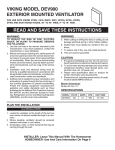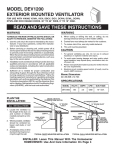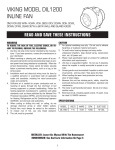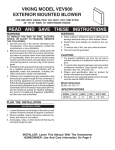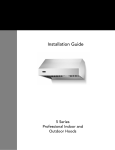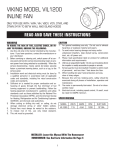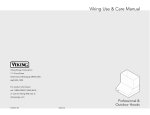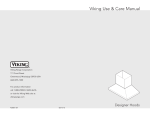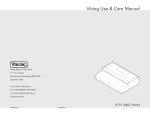Download Quick Reference Guide
Transcript
Settings and Functions (Professional VWH, VCWH, VCIH, VBCV & VEWDO ) Cleaning and Maintenance (Designer DCWH) Cleaning and Maintenance Any piece of equipment works better and lasts longer when maintained properly and kept clean. Ventilation equipment is no exception. Your hood must be kept clean and maintained properly. ALWAYS turn on your hood before you begin cooking to establish airflow in the kitchen. Also, let the blower run for a few minutes to clear the air after you turn off your cooking appliance. This will help keep the kitchen air cleaner. ON/OFF switch—Starts and stops the blower. When turned on the blower will operate at the previous setting of the speed control. Blower speed knob—Turn the knob counterclockwise to decrease the blower speed and clockwise to increase speed. The type of cooking you are doing will dictate the speed of the blower you use. Light switch—Controls the 50-watt halogen lights located in the front of the hood. Dimmer knob—Turn the knob clockwise to brighten the halogen lights and counterclockwise to dim the lights. Heat lamp switches—Turn the heat lamps on and off. Each professional wall hood will be equipped with one or two heat lamp outlets. The 250-watt infrared bulbs are not included and should be purchased locally. CAUTION Cleaning Baffle Filters As air passes through a baffle filter, grease particles collect on the stainless steel U-shaped baffle channels and drip down into the bottom of the filter. Baffle filters are extremely efficient when compared to mesh filters. The power of the hood is increased as more air passes through a baffle filter than with mesh filters, which are usually dirty. Baffle filters are almost universally required in commercial installations due to their superior ability to capture grease. The baffle filters should be examined periodically to assure that all surfaces and parts are clean. The filters can be washed in a dishwasher or in a sink with hot, soapy water. Simple periodic cleaning will ensure maximum filter effectiveness. Using VEWDO Outdoor Hood (Damp Environment Approved Models Only) • T-Series hood models should be installed in a covered yet non-enclosed area. They should also be protected from natural elements (such as rain) as much as possible. • ALWAYS turn the hood on to the “HIGH” position before lighting the grill. • Keep the grill canopy closed as much as possible when cooking so smoke is exhausted from the back of the grill. This allows for optimum performance of the hood. • During breezy conditions, outdoor hoods may not perform well. ALWAYS turn on your hood before you begin cooking to establish airflow in the kitchen. Also let the blower run for a few minutes to clear the air after you turn off your cooking appliance. This will help keep the kitchen air cleaner. Light knob—Push once to turn lights on. Push again to turn lights off. Rotate clockwise to increase light intensity and counterclockwise to decrease light intensity. Light setting will stay the same when turned on or off. Fan knob—Push once to turn blower on. Push again to turn blower off. Rotate clockwise to increase blower speed and counterclockwise to decrease blower speed. Digital display—Remains blank while timer/delay functions are not in use. Displays desired set time which is set by either the set button or delay function button. Upon reaching 00:00, the buzzer will sound and will continue to beep every 10 seconds up to 5 minutes. Delay feature button—Pushing this button once will automatically set the digital display to 10 minutes. Pushing again will go to 20 minutes and so forth, up to 30 minutes. The blower will activate and the timer will start counting down until 00:00 is reached. At this time the display will go blank and blower will cut off. Scroll up button—Changes timer display upward to 12 hours. Scroll down button—Changes timer display downward to 00:00. Set button—Pushing once will activate display (00:00) and allow you to enter time using the scroll up or scroll down buttons. The blower cannot be activated using the set button. Only the timer will be activated. Upon reaching 00:00, the buzzer will sound and will continue to beep every 10 seconds up to 5 minutes. Slide spacer forward off of rear lip. Lower spacer rear, then slide spacer front out. • Do not use caustic detergent to clean the filters. An abrasive or corrosive cleaner may damage the finish. • Do not take the baffle filters apart to clean them. It is not necessary and will void the filter warranty. Cleaning Mesh Filters (DCWH only) As air passes through the filter, grease particles collect on the stainless steel screen inside the filter. The filters should be examined periodically to assure that all surfaces and parts are clean. This unit is equipped with an alarm. Once the unit has been in operation for 48 hours, the letters “FILT” will appear on the display. The filters can then be washed in a dishwasher or in a sink with hot, soapy water. Simple periodic cleaning will ensure maximum effectiveness. Do not use caustic detergent to clean the filters. An abrasive or corrosive cleaner may damage the finish. Do not take the filters apart to clean them. It is not necessary and will void the filter warranty. Once the filters have been cleaned and placed back in the hood, the display is canceled by holding the scroll up (+) and the scroll down (-) buttons for 5 seconds. Slide filter front over front lip. Push filter rear up, then slide back over rear lip. Slide filter forward off of rear lip. Lower filter rear, then slide filter front out. Slide filter front over front lip. Push filter rear up, then slide back over rear lip. Slide filter forward off of rear lip. Lower filter rear, then slide filter front out. DO NOT place flammable material on warming shelves when using heat lamps. When cleaning filters in 18”H. hoods, always remove the grease trough and clean by soaking in a sink with hot soapy water. Important Safety Instructions (Please Read and Save these Instructions) Warning and Important Safety Instructions appearing in this guide are not meant to cover all possible conditions and situations that may occur. Common sense, caution, and care must be exercised when installing, maintaining, or operating the appliance. ALWAYS contact the manufacturer about problems or conditions you do not understand. Recognize Safety Symbols, Words, Labels Read and follow all instructions before using this appliance to prevent the potential risk of fire, electric shock, personal injury or damage to the appliance as a result of improper usage of the appliance. Use appliance only for its intended purpose as described in this guide. DANGER Hazards or unsafe practices which WILL result in severe personal injury or death WARNING Hazards or unsafe practices which COULD result in death severe personal injury or death CAUTION Hazards or unsafe practices which COULD result in minor personal injury. All safety messages will identify the hazard, tell you how to reduce the chance of injury, and tell you what can happen if the instructions are not followed. WARNING To reduce the risk of fire, electric shock, or injury to persons, observe the following: • Use this unit only in the manner for which it is intended. If you have any questions, contact the manufacturer. • Before servicing or cleaning unit, switch power off at service panel and lock service panel to prevent power from being switched on accidentally. When the service disconnecting means cannot be locked, securely fasten a prominent warning device, such as a tag, to the service panel. WARNING WARNING To reduce the risk of fire, electric shock, or injury when using your unit, observe the following: • Installation work and electrical wiring must be done by qualified person(s) in accordance with all applicable codes and standards, including firerated construction. • Sufficient air is needed for proper combustion and exhausting of gases through the flue (chimney) of fuel burning equipment to prevent back drafting. Follow the heating equipment manufacturer’s guideline and safety standards such as those published by the National Fire Protection Association (NFPA), and the American Society for Heating, Refrigeration and Air Conditioning Engineers (ASHRAE), and the local code authorities. • When cutting or drilling into wall or ceiling, do not damage electrical wiring and other hidden utilities. • Ducted fans must always be vented to the outdoors. WARNING To reduce the risk of a rangetop grease fire: • NEVER leave surface units unattended at high settings. Boil- overs cause smoking and greasy spillovers that may ignite. Heat oils slowly on low or medium settings. • ALWAYS turn hood ON when cooking at high heat or when cooking flaming foods. • Clean ventilating fans frequently. Grease should not be allowed to accumulate on fan or filters. • Use proper pan size. ALWAYS use cookware appropriate for the size of the cooking area. WARNING Important Safety Instructions Viking Quick Reference Guide (Please Read and Save these Instructions) WARNING To reduce the risk of injury to persons in the event of a rangetop grease fire, observe the following: (Based on “Kitchen Firesafety Tips,” published by NFPA.) 1. SMOTHER FLAMES with a close fitted lid, cookie sheet, or metal tray, then turn off the burner. BE CAREFUL TO PREVENT BURNS. If the flames do not go out immediately, EVACUATE AND CALL THE FIRE DEPARTMENT. 2. NEVER PICK UP A FLAMING PAN. You may be burned. 3. DO NOT USE WATER, including wet dishcloths or towels a violent steam explosion will result. 4. Use an extinguisher ONLY if • You know it is a Class ABC extinguisher, and you already know how to operate it. • The fire is small and contained in the area where it started. • The fire department is being called. • You can fight the fire with your back to an exit. WARNING TO REDUCE THE RISK OF FIRE, ELECTRICAL SHOCK, OR INJURY TO PERSONS, RANGEHOODS MUST BE INSTALLED WITH THE VENTILATORS THAT ARE SPECIFIED ON THEIR CARTON INDICATING SUITABILITY WITH THIS MODEL. OTHER VENTILATORS CANNOT BE SUBSTITUTED. CAUTION For general ventilating use only. DO NOT use to exhaust hazardous or explosive materials and vapors. CAUTION If the power to the hood is not disconnected during cleaning, the heat sensor thermostat can cause the blower to turn on. CAUTION Unplug power cords from control panel before cleaning or servicing hood. CAUTION DO NOT place flammable material on warming shelves when using heat lamps. CAUTION All brass special ordered parts are coated with an epoxy coating. DO NOT use brass cleaners or abrasive cleansers on the brass option parts. CAUTION DO NOT use a porcelain cleaner or rough abrasive cleaner. CAUTION To reduce risk of fire and to properly exhaust air, be sure to duct air outside. DO NOT vent exhaust air into spaces within walls or ceilings, or into attics, crawl spaces, or garages To reduce the risk of fire, electric shock, or injury to persons, observe the following: • Use this unit only in the manner for which it is intended. If you have any questions, contact the manufacturer. • Before servicing or cleaning unit, switch power off at service panel and lock service panel to prevent power from being switched on accidentally. When the service disconnecting means cannot be locked, securely fasten a prominent warning device, such as a tag, to the service panel. To reduce the risk of fire, use only metal ductwork. Professional & Outdoor Hoods F20598B EN VIKING RANGE CORPORATION 111 Front Street • Greenwood, Mississippi 38930 USA • (662) 455-1200 (082012) Note: In the event electronic capabilities or internet access is not available, please HALT the installation process until printed documents are available. You will receive, free of charge, a complete set of printed documents by contacting Viking Customer Service at 1-888-Viking1 (845-4641).


